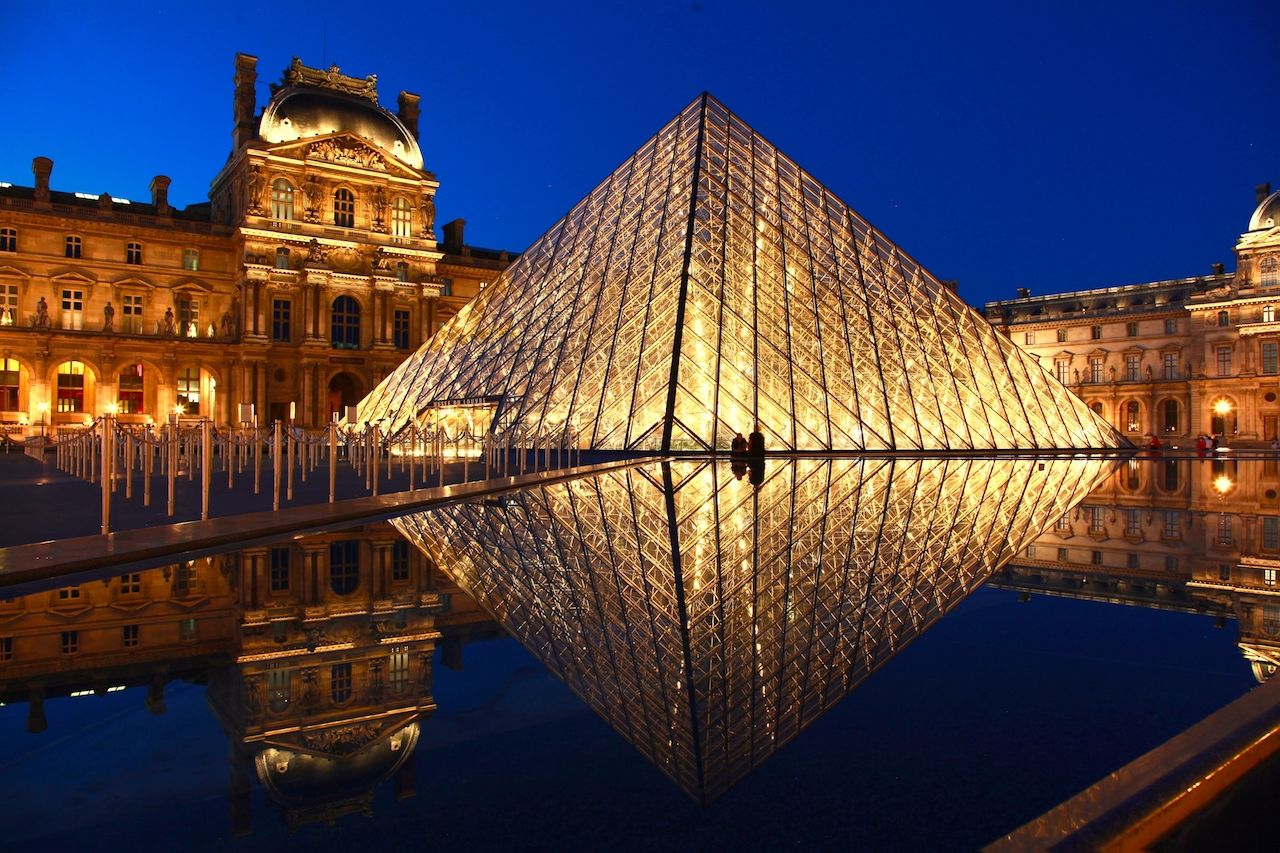
The Louvre Pyramid is one of the most iconic landmarks in Paris, attracting millions of visitors each year. Designed by renowned architect I.M. Pei, the pyramid has become a symbol of the Louvre Museum and a testament to modern architecture. However, there is more to this enigmatic structure than meets the eye. With its unique design and intriguing history, the Louvre Pyramid leaves visitors awe-inspired and curious to learn more. In this article, we will delve into 18 fascinating facts about the Louvre Pyramid, shedding light on its construction, symbolism, and its role as a modern architectural marvel amidst a historic setting. Join us as we explore the mysteries and wonders of this captivating landmark.
Key Takeaways:
- The Louvre Pyramid is a stunning glass and metal structure in Paris, serving as the main entrance to the Louvre Museum. It symbolizes the blend of modernity and history, captivating visitors from around the world.
- With its impressive dimensions and influence on architecture, the Louvre Pyramid has become a symbol of French culture and a popular selfie spot. Its enigmatic allure continues to spark fascination and debate.
The Louvre Pyramid is an architectural masterpiece
The Louvre Pyramid is arguably one of the most iconic architectural structures in the world. Designed by renowned architect I. M. Pei, this magnificent glass pyramid sits proudly in the courtyard of the Louvre Museum in Paris, France. Its distinct geometric shape and transparency create a captivating and enigmatic allure for visitors from around the globe.
The pyramid is made of glass and metal
The Louvre Pyramid is an impressive feat of engineering, consisting of around 603 glass rhombus and 70 triangular segments. The glass panels create a stunning reflective effect, emphasizing the pyramid’s elegance and grandeur. The metal framework provides the necessary structural support, allowing the pyramid to stand tall and withstand the test of time.
The construction of the pyramid sparked controversy
When the plans for the Louvre Pyramid were unveiled, they were met with mixed reactions. Some praised the innovative and modern design, while others criticized it as an intrusion on the traditional architecture of the Louvre Museum. Nevertheless, the pyramid’s construction began in 1984 and was completed in 1989, marking a new chapter in the history of the Louvre.
The pyramid serves as the main entrance to the Louvre Museum
At the time of its construction, the Louvre Pyramid was introduced as the new main entrance to the prestigious Louvre Museum. It replaced the smaller and less prominent entrance, providing a more accessible and welcoming passage for the millions of visitors who flock to the museum each year.
It is surrounded by three smaller pyramids
The Louvre Pyramid is not alone in its splendor. It is accompanied by three smaller pyramids, known as the Pyramidions, which are strategically placed around the main pyramid. These smaller pyramids, made of metal, further enhance the majestic ambiance of the Louvre courtyard.
The pyramid’s dimensions are impressive
The Louvre Pyramid stands 21.6 meters (71 feet) tall, making it a commanding presence in the museum’s courtyard. It has a base length of 35 meters (115 feet) on each side, perfectly proportioned to create a sense of harmony and balance. Its dimensions have been carefully calculated to fit seamlessly within the surrounding architecture.
It serves as a skylight for the underground space
Beneath the Louvre Pyramid lies a vast underground space that houses various galleries, exhibition rooms, and visitor facilities. The pyramid’s transparency allows natural light to flood this underground area, creating a stunning interplay between light and shadow. This unique design feature adds an element of mystique to the overall museum experience.
The pyramid has become a symbol of French culture
Since its completion, the Louvre Pyramid has become synonymous with French culture and has come to represent a harmonious blend of heritage and modernity. It has been featured in numerous films, books, and artworks, further cementing its status as a cultural icon.
The pyramid’s design is influenced by the Great Pyramid of Giza
The Louvre Pyramid pays homage to the ancient Egyptian pyramids, particularly the Great Pyramid of Giza. The structural similarities and geometric precision are undeniable, connecting the Louvre Pyramid to the rich history of pyramid architecture.
It took more than two years to construct the pyramid
The construction of the Louvre Pyramid was no small feat. It took a dedicated team of architects, engineers, and workers more than two years to bring this visionary design to life. The attention to detail and meticulous planning is evident in every aspect of the pyramid’s construction.
The pyramid can be enjoyed from different perspectives
Visitors to the Louvre Museum can experience the Louvre Pyramid from various vantage points. Whether standing directly in front of it or admiring it from different angles, the pyramid never fails to captivate with its symmetrical beauty and captivating allure.
The pyramid is lit up at night
As the sun sets, the Louvre Pyramid undergoes a mesmerizing transformation. Illuminated from within, the pyramid becomes a stunning beacon of light, casting a magical glow over the surrounding courtyard. This nighttime spectacle adds to the pyramid’s enigmatic charm and attracts nocturnal admirers.
It has become a popular selfie spot
In the age of social media, the Louvre Pyramid has gained popularity as a prime selfie spot. Visitors can be seen striking various poses and capturing the perfect shot with the pyramid as their backdrop, creating lasting memories of their visit to this extraordinary architectural wonder.
The pyramid has hosted temporary art installations
Over the years, the Louvre Pyramid has provided a unique setting for temporary art installations. Artists from around the world have utilized the pyramid’s striking form and symbolism to create thought-provoking and immersive art experiences, further highlighting its versatility and artistic appeal.
The pyramid has inspired other architectural designs
The influence of the Louvre Pyramid goes beyond its own structure. Its innovative design and bold statement have inspired architects around the world. Numerous buildings and structures have taken inspiration from the Louvre Pyramid, showcasing its lasting impact on the world of architecture.
The pyramid represents the merging of past and present
The Louvre Pyramid stands as a symbol of the harmonious coexistence of past and present. Its modern design seamlessly integrates with the historical backdrop of the Louvre Museum, creating a visual representation of the museum’s mission to preserve and showcase the world’s artistic treasures.
The Louvre Pyramid has its own underground entrance
Beneath the Louvre Pyramid, there is a hidden underground entrance that allows for discreet and exclusive access to the museum. This entrance is reserved for special guests, such as dignitaries and VIPs, adding an air of mystery and exclusivity to their museum experience.
The pyramid has sparked debate and speculation
Throughout its history, the Louvre Pyramid has continued to spark debate and speculation. From discussions on its architectural significance to theories about hidden messages embedded in its design, the pyramid has become a subject of fascination and intrigue for both experts and enthusiasts.
Conclusion
The Louvre Pyramid is an architectural marvel that has captured the imaginations of millions of visitors from around the world. With its enigmatic design and rich history, it stands as a symbol of beauty, innovation, and cultural significance. From its controversial beginnings to its role as a cultural icon, the Louvre Pyramid continues to inspire and intrigue visitors to this day.
FAQs
Q: Who designed the Louvre Pyramid?
A: The Louvre Pyramid was designed by renowned architect I.M. Pei. His modernist approach and innovative design transformed the entrance of the Louvre Museum into a stunning masterpiece.
Q: When was the Louvre Pyramid unveiled?
A: The Louvre Pyramid was unveiled on March 29, 1989, as part of President François Mitterrand’s Grands Projets initiative. It marked a significant moment in the history of the Louvre Museum.
Q: How tall is the Louvre Pyramid?
A: The Louvre Pyramid reaches a height of approximately 21.6 meters (71 feet). It consists of a structural frame made of steel and glass panels, giving it a striking appearance.
Q: What is the purpose of the Louvre Pyramid?
A: The Louvre Pyramid serves as the main entrance to the Louvre Museum. Its purpose is to facilitate the flow of visitors into the museum and provide a visually striking architectural element.
Q: How many glass panes are there in the Louvre Pyramid?
A: The Louvre Pyramid is made up of 673 glass panes. These panes create a stunning geometric pattern and allow natural light to illuminate the entrance hall.
Q: Did the construction of the Louvre Pyramid face opposition?
A: Yes, the construction of the Louvre Pyramid faced significant opposition initially. Some critics felt that the modern design clashed with the historical surroundings, but it has since become an integral part of the landscape.
Q: Is the Louvre Pyramid open to the public?
A: Yes, the Louvre Pyramid is open to the public. Visitors can enter the museum through the Pyramid’s grand entrance and explore the vast collection of art and historical artifacts housed within the Louvre Museum.
The Louvre Pyramid's enigmatic allure captivates visitors, but there's more to discover about Paris' iconic Louvre Museum. From its vast collection to lesser-known secrets, uncover fascinating facts that make this world-renowned institution a must-see. For those passionate about contemporary art exhibitions, exploring the Gwangju Biennale provides an immersive experience into cutting-edge works from around the globe. And behind the Louvre Pyramid's striking design stands a visionary architect – I.M. Pei – whose life and career are filled with intriguing stories waiting to be unveiled.
Was this page helpful?
Our commitment to delivering trustworthy and engaging content is at the heart of what we do. Each fact on our site is contributed by real users like you, bringing a wealth of diverse insights and information. To ensure the highest standards of accuracy and reliability, our dedicated editors meticulously review each submission. This process guarantees that the facts we share are not only fascinating but also credible. Trust in our commitment to quality and authenticity as you explore and learn with us.


